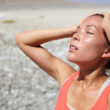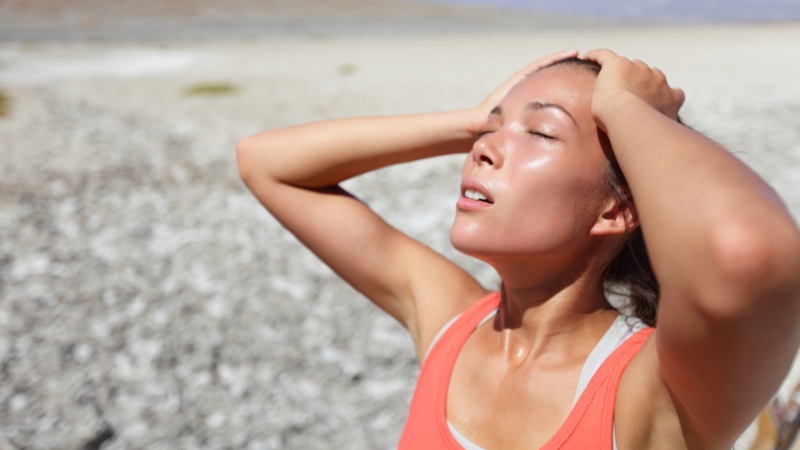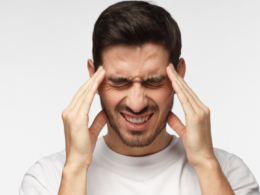It’s the warmest time of year, and with temperatures soaring, it’s more important to be mindful of Heatstroke. Heatstroke is a serious condition that can lead to death or permanent disability if untreated, so knowledge about how to prevent it and what to do if you have one is essential for everyone’s well-being. In this article, we’ll go through all aspects of Heatstroke – symptoms and prevention techniques to treatments – to help you stay safe in summer.
Did you know Heatstroke is one of the Most Serious forms of Hyperthermia?
Heat stroke occurs when your body temperature rises to 104 F (40 C) or higher due to hot weather, physical activity, and other external factors. Without treatment, it can lead to unpleasant symptoms such as nausea, headaches, dizziness, and confusion. It would be best to learn how to prevent Heatstroke so you don’t end up in this dangerous situation.
We want to help equip you with knowledge on staying safe from Heatstroke during those hot summer days! We will advise on what steps should be taken if someone is experiencing the signs of Heatstroke and provide prevention tips. Knowing what causes it and which situations are at risk will ensure that summers remain a pleasant experience for everyone!
Heatstroke and its health risks
Heatstroke is a condition that can occur as a result of prolonged exposure to high temperatures, whether it be from the sun, a hot environment, or intense physical activity. As the body’s temperature rises to dangerous levels, it struggles to cool itself down through sweating and other mechanisms.
In serious cases, Heatstroke can lead to:
- Organ failure.
- Brain damage.
- Death.
It’s important to stay aware of the risks of Heatstroke, especially in the summer months, and to stay cool and hydrated. Remember to drink plenty of water, wear light and loose clothing, and avoid strenuous activity during the hottest parts of the day.
Keep an eye out for symptoms like headache, dizziness, nausea, and difficulty breathing, and seek medical attention immediately if you suspect that Heatstroke is present. Stay safe and enjoy the summer healthily and responsibly.
Tips on How to Prevent Heatstroke
Summertime can be a lot of fun, but the risk of Heatstroke comes with the heat. It’s important to take steps to prevent it; luckily, it’s not too difficult.
Here are some tips for preventing Heatstroke:
Wear light, loose-fitting clothing
When it comes to getting dressed for a hot summer day, it’s important to choose comfortable and functional clothing. That’s why we recommend wearing light, loose-fitting clothing. This type of clothing will allow your skin to breathe and reduce your risk of overheating and keep you feeling comfortable and stylish.
Whether planning a day at the beach or running errands around town, light, airy fabrics like cotton and linen will keep you feeling cool and looking great. So why not ditch the tight clothes and opt for something more comfortable this season? Your body will thank you, and you’ll look fabulous while doing it.
Stay hydrated and drink plenty of water.
Staying hydrated is essential for maintaining a healthy body and mind. Drinking plenty of water is a simple yet effective way to stay hydrated throughout the day. Water is vital for carrying nutrients and oxygen to your cells and removing waste products from your body. It also helps regulate body temperature and can improve cognitive function.
Drinking at least eight glasses of water a day is recommended, but this may vary depending on your activity levels and climate. Remember to listen to your body’s signals of thirst and have a water bottle handy while out and about. Staying hydrated will help you feel better physically and mentally, so go ahead and take a sip!
Limit outdoor activities during the hottest parts of the day.
To stay safe and comfortable during hot summer days, limiting your exposure to the sun during peak hours is essential. This means avoiding outdoor activities during the hottest parts of the day, typically between 11 a.m. and 3 p.m. The sun’s rays are strongest during this time, making it easy to become overheated or dehydrated. Instead, plan your activities in the morning or evening when temperatures are cooler.
And if you need to be outside during peak hours, wear sunscreen, a hat, and loose, lightweight clothing to stay cool and protected. Taking a few simple precautions allows you to enjoy all the fun and excitement of summer without putting yourself at risk.
What are the Causes of Heatstroke?
Many factors can increase your risk of developing Heatstroke. These include prolonged exposure to hot temperatures, direct sunlight, humidity, physical activity, and certain medications or medical conditions.
Other causes may include:
- Dehydration.
- Alcohol use.
- Conditions like heart disease or diabetes.
It’s important to understand what can put you at risk of Heatstroke so that you can take the necessary precautions. Wearing loose-fitting clothing and drinking plenty of water are two easy ways to prevent it, but if necessary, don’t forget to seek medical attention immediately if you suspect Heatstroke is present.
Common Warning Signs of Heatstroke
As summer approaches, it’s important to be aware of the potential dangers associated with high temperatures and prolonged exposure to the sun.
Heatstroke is a serious condition that can be life-threatening if left unchecked.
Fortunately, several common warning signs can help you identify Heatstroke in yourself or others.
These may include:
- Headache.
- Dizziness.
- Nausea or vomiting.
- Rapid heartbeat.
- High body temperature.
If you or someone you know is experiencing any of these symptoms, it’s important to seek medical attention immediately and cool down. Stay safe in the heat this summer by knowing the warning signs of Heatstroke and taking preventative measures to avoid it.
Explain First Aid Treatment for Heatstroke
It’s important to be prepared for hot weather and to know how to treat Heatstroke if it does occur. Heatstroke occurs when the body temperature rises too high and the body cannot cool itself down.
Symptoms include:
- Confusion.
- Headache.
- High body temperature.
If you suspect someone is suffering from Heatstroke, remove them from the heat immediately and cool them down by placing them in a cool, shaded area and giving them water to drink. Apply cool water to their skin and use a fan or anything else that may help to cool them down.
Seek medical attention as soon as possible if the person’s condition does not improve. HHeatstroke can be managed effectively with the correct treatment, and recovery can be swift.
When to Seek Medical Attention for Heatstroke Symptoms?
It’s common to experience minor discomfort when out in the sun for long periods. However, Heatstroke is a lot more serious and requires immediate medical attention. If you’re experiencing symptoms such as a high body temperature, rapid heartbeat, headache, or confusion, you must seek medical help immediately.
Heatstroke can rapidly cause damage to your internal organs and even be life-threatening if not treated quickly. Don’t hesitate to ask for assistance, and remember to stay hydrated, seek shade whenever possible, and wear loose-fitting, lightweight clothing to help prevent Heatstroke from occurring in the first place.
Frequently Asked Questions About Heatstroke
Q: How can I prevent Heatstroke?
A: The best way to prevent Heatstroke is to stay hydrated, wear light and lose clothing, limit outdoor activities during the hottest parts of the day, and apply sunscreen when needed.
Q: What should I do if I think I have Heatstroke?
A: If you think you have Heatstroke, it’s important to seek medical help immediately. Remove yourself from the heat and find a cool, shaded area. Drink plenty of water and apply cool water or ice packs to your skin to help lower body temperature.
Q: Are there any long-term effects of Heatstroke?
A: Yes, long-term effects of Heatstroke can include organ damage, heat exhaustion, and even death.
Q: Is there anything else I should know about Heatstrokes?
A: Make sure that you check on your family, friends, and pets during hot summer days. It’s important to stay informed about weather reports and take all necessary precautions to prevent Heatstroke.
Q: Who are the people most at risk for Heatstroke?
A: People with chronic medical conditions, older people, and young children are likelier to suffer from Heatstroke.
In Conclusion
Heatstroke is a serious health concern that should be taken seriously, as it can lead to severe medical complications and even death. To avoid any risk of contracting this illness, you must take preventive measures such as wearing weather-appropriate clothing, staying hydrated, and limiting outdoor activities during the hottest parts of the day. Suppose you suspect you or someone else is developing symptoms of heatstroke. In that case, it’s important to know the warning signs, such as confusion, nausea, and dizziness, so that you can seek help immediately.
Planning to beat the summer heat is key to avoiding illnesses related to extreme temperatures, such as heat stroke. Knowing how to keep yourself safe and healthy should mean you and your loved ones enjoy the summer months without worry!









